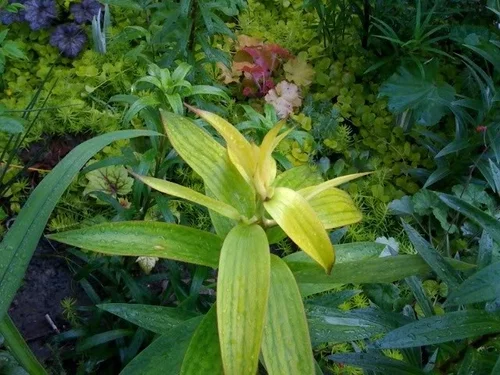Lilies are one of the most exotic offerings of nature. Often held in association with purity, devotion, good luck, youth, rebirth, and even love, these colorful and fragrant flowers are honestly a delightful inclusion in your garden. Lamar Cole very rightly said about the beauty of lilies in his poetry.
Although typically easy to grow and maintain, it is not out of the ordinary for your lily plants to be struck by stresses. Asiatic lily leaves turning yellow, though a lesser common problem than say the browning or wilting of leaves, can often occur, leaving you slightly terrified.
Do not worry, you can take a deep breath and read along because we are about to take you through how you can fix the yellowing of your precious lily leaves and restore the health of these exquisite plants.
What are Asiatic Lilies?
Asiatic lilies are among the most common hybrids of lilies right after oriental lilies. They are also called Lilium Asiatic. There are almost 50 variants of Asiatic lily such as Tiny Rocket, Tiny Ghost, Tiny Double You, Tiny Todd, Strawberry Custard, Tiger Babies, Eyeliner, and so on.
According to the U.S. Department of Agriculture (USDA) zones, Asiatic lilies are hardy 4 to 9. As the name suggests, Asiatic lilies are native to Asia, and although are typically less fragrant than other hybrids and cultivars of lilies, they are known for the countless number of color shades they come from.
Starting from dark crimson, light orange, lavender, pink, and yellow to shades of pastels and bi-colors, Asiatic lilies never fail to mesmerize us with their color offerings. This particular lily hybrid is the shortest of all. They typically grow up to 2-6 feet high. Just like their other siblings, they are low-maintenance plants that can elevate the beauty of your garden easily.
Reasons Behind Asiatic Lily Leaves Turning Yellow and How to Fix Them

Why Are My Asiatic Lily Leaves Turning Yellow?
Normally, the yellowing of leaves is associated with health issues in your Asiatic lily plant. Although it could be due to the lily’s nature of shedding at the end of the growing season as discussed later, yellow leaves before or after bloom may indicate some problems.
1. Lily Life Cycle
Asiatic lilies are early bloomers and they usually come in full bloom around spring. Before that, towards the end of fall, lilies tend to lose their leaves like olive and regrow them during spring. Before shedding, it is normal for leaves to take on a yellow hue, and then gradually turn brown right before falling off.
Therefore, the yellowing of leaves during the season is nothing to worry about.
2. Under or Over Watering
Leaves turning yellow can be an indication that you are either over or under watering your lily plants. While lilies, being tropical flowers, usually love water, too much water can begin to rot the bulb, eventually hindering the uptake of water and nutrients, causing the plan to get weaker with time and eventually die.
On the other hand, if you underwater your lily, it might be dehydrated. If your leaves are showcasing a yellow or brown shade and are drooping slowly, chances are you are not feeding enough water to them.
Remember for your lilies to be in good health, you need to ideally maintain evenly moist and loose soil that is not too wet and not too dry.
3. Poor Soil
Asiatic lily grows best in slightly acidic soil with 6.5 to 7 pH having moist, not sopping wet. When the soil has lower or higher pH that means too much acidic or alkalic, this could be a potential threat to them and could turn Asiatic lily leaves turning yellow.
4. Improper Drainage
If too much water collects around the bulb of your lily plant, the bulb might rot causing the slow death of your plant. Potted or not, it is recommended to maintain proper soil drainage to avoid rotting.
5. Too Much or Too Little Sunlight
Lilies are generally not huge fans of the sun and in fact, they do not require as much sunlight either, the reason why they can also be grown indoors. Exposure to too much direct sunlight can scorch the leaves leading them to wilt and turn yellow and brown around the edges.
Then again, constant deprivation from sunlight can technically come in the way of photosynthesis, causing them to gradually lose their natural green color and eventually die.
6. Lack of Nutrition
If the veins of your lily leaves remain green while the leaves of the lower portion of the plant start turning yellow, it could mean that your Asiatic lily is a victim of lack of nutrition, especially that of nitrogen and some micronutrients like magnesium and iron.
While it is true that you do not need to depend on heavy fertilizers to keep your Asiatic lily, nutrition deficiency can typically occur if your lily is in the same pot for a prolonged time and therefore have a tendency of having used up all the nutrients in the soil (like the mistake of garden soil being used in pots).
Having said that, even too much nutrition, although will cause rapid growth of foliage, you will notice yellowness around the edge and blooming might be deterred.
7. Pests and Diseases
Lily plants are susceptible to several diseases and infestations, some of which are life-threatening. The prolonged attack can cause lily leaves to turn yellow and, in some cases, die.
Starting from aphids, mealybugs, spider mites, bulb flies, bulb mites, snails, and slugs, lily plants might end up hosting a bunch of sap-sucking and bulb attacking bugs. They can also suffer from a bunch of fungal diseases like grey mold and rust that can cause the bulbs to rot.

Image Source: houzz.com
How to Save A Dying Lily Plant?
1. Understand Its Watering Habits
As mentioned already, lilies prefer slightly damp soil, so you might consider watering your plant only when the top layer of soil is dry. Deep watering your lily once a week is ideal, and you can sprinkle water in the leaves throughout summer to keep up their sparkle.
2. Ensure Proper Drainage
If you have a potted plant, make sure there are sufficient holes underneath and preferably a saucer to catch the excess water to ensure proper draining. You can also boost soil drainage by adding organic matter like slug compost or manure or fiber-rich ingredients like coconut husk.
3. Adjust Lighting
As you can tell, both over and underexposure to sunlight can turn the leaves of your Asiatic lily yellow. Instead, try moving your plant to an east-facing, semi-shaded area. During off-bloom seasons, you can also keep them indoors since they also tend to strive in fluorescent lighting.
4. Fix Nutrition Levels of The Soil
Generally, a good way of identifying problems with the nutrition level of the soil is to get a soil test done. Carrying out soil testing or not, if your lily is in the same pot over a long time, you might need to fertilize. A 10-20-20 (Nitrogen-Phosphorus-Potassium) mix of slow-release fertilizer would work best for Asiatic lily.
5. Remove Bugs and Fungus from The Plant
If you have a bug infestation in your lily plant, you can try removing them with high-force water spraying. Organic plant-friendly insecticides such as neem oil and water solution can also help get rid of pests. You can also consider swabbing your leaves with alcohol-drenched cotton to keep bugs away in the future.
Also, waterlogged soils tend to encourage fungal growth so you might want to thoroughly maintain the level of dampness in your soil to keep fungus away.
Frequently Asked Questions On Asiatic Lily
How many types of lilies are there?
There are almost 90 species of lilies around the world. Out there the most popular ones are Asiatic, Oriental, and Aurelian lilies.
What are the common problems of Asiatic lily?
Answer: Garden pests and fungal disease two most common Asiatic lily problems.
Conclusion
We admit that seeing your Asiatic lily leaves turning yellow, which otherwise flaunts a bright green color is upsetting and intimidating like watching your apple leaves turning red. However, do not worry – by bearing that yellow hue, your plant is just trying to tell you that it is facing difficulty and when that happens you will just need to dig deeper into the roots, literally!
Yellowing of leaves is very much fixable and in fact, this will help you understand the overall needs of your Asiatic lily better, helping you to better maintain them.

I’m Shofi, a passionate gardener and blogger. I have 10+ years of experience in gardening and hold certifications in horticulture and garden design. I share my knowledge and skills through my garden blog to inspire and educate others on the joys of gardening. I try to provide valuable information and create a community for gardeners of all levels to connect and learn. My ultimate goal is to inspire others to start their own gardens and connect with nature.

1 thought on “The Reasons Behind Asiatic Lily Leaves Turning Yellow and How to Save A Dying Asiatic Lily”